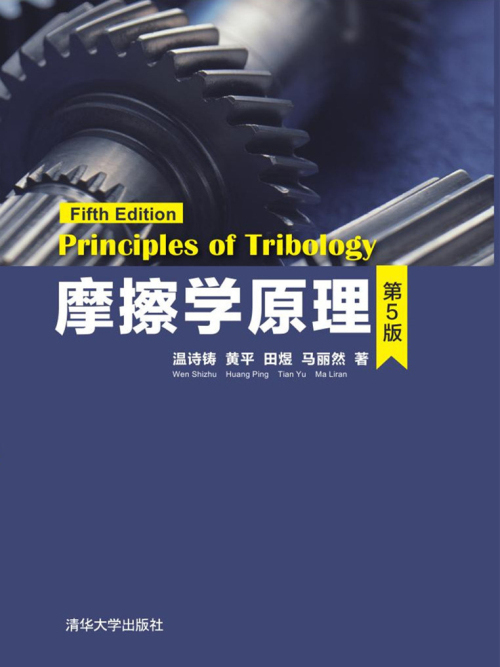內容簡介
《摩擦學原理(第5版)》反映了摩擦學研究進展以及作者和同事們從事該領域研究的成果,系統地闡述摩擦學的基本原理與套用,全面反映現代摩擦學的研究狀況和發展趨勢。 全書共22章,由潤滑理論與潤滑設計、摩擦磨損機理與控制、套用摩擦學等三部分組成。除摩擦學傳統內容外,還論述了摩擦學與相關學科交叉而形成的研究領域。本書針對工程實際中各種摩擦學現象,著重闡述在摩擦過程中的變化規律和特徵,進而介紹基本理論和分析計算方法以及實驗測試技術,並說明它們在工程中的實際套用。 《摩擦學原理(第5版)》可作為機械設計與理論專業的研究生教材和高等院校機械工程各類專業師生的教學參考書,亦可供從事機械設計和研究的工程技術人員參考。
圖書目錄
Part OneLubrication Theory and Lubrication Design
Chapter 1Properties of lubrication film
1.1Lubrication states
1.2Density of lubricants
1.3Viscosity of fluids
1.4NonNewtonian properties and rheological model
1.5Lubricant wettability
1.6Measurement and exchange of viscosity
References
Chapter 2Basic theory of hydrodynamic lubrication
2.1Reynolds equation
2.2Hydrodynamic lubrication
2.3Basic elasticity theory of contact problems
2.4Elastohydrodynamic lubrication (inlet analysis)
2.5Grease lubrication
2.6Elastohydrodynamic lubrication state diagrams
References
Chapter 3Numerical methods of lubrication calculation
3.1Numerical solutions of Reynolds equation
3.2Numerical solutions of energy equation
3.3Numerical solutions of elastohydrodynamic lubrication
3.4Multigrid level method used in lubrication problems
References
Chapter 4Lubrication design of typical mechanical elements
4.1Slider and thrust bearing
4.2Journal bearing
4.3Hydrostatic bearing
4.4Squeezing bearing
4.5Dynamic bearing
4.6Gas bearing
4.7Rolling contaet bearing
4.8Gear lubrication
4.9Cam lubrication
References
Chapter 5Lubrication of special fluid medias
5.1Magneto fluid lubrication
5.2Micropolar fluid lubrication
5.3Liquid crystal lubrication
5.4Double electric layer effect in water thin film lubrication
5.5Emulsion lubrication
References
Chapter 6Transformation of lubrication states and nano thin film lubrication
6.1Transformation of lubrication states
6.2Nano film lubrication of liquid
6.3Numerical analysis of thin film lubrication
6.4Nano film lubrication of gas
References
Chapter 7Boundary lubrication and additives
7.1Types of boundary lubrication
7.2Theory of boundary lubrication
7.3Additives of lubricant
References
Chapter 8Lubrication failure and mixed lubrication
8.1Influence of roughness and material viscoelastic property on lubrication
failure
8.2Influence of fluid limiting shear stress on lubrication failure
8.3Influence of temperature on lubrication failure
8.4Mixed lubrication state
References
Part TwoFriction and Wear Mechanisms and Friction Control
Chapter 9Surface topography and surface contacts
9.1Parameters of surface topography
9.2Statistic parameters of surface topography
9.3Rough surface contacts
References
Chapter 10Soliding friction and its applications
10.1Basic characteristics of friction
10.2Macro friction theory
10.3Micro friction theory
10.4Sliding friction
10.5Other friction problems and friction control
References
Chapter 11Fretting friction and its applications
11.1Development and classification of fretting tribology
11.2Theory of fretting friction
11.3Approches of improving fretting performance
11.4Researches on the applications of fretting tribology
References
Chapter 12Rolling friction and its applications
12.1Basic theories of rolling friction
12.2Wheelrail rolling friction and thermal analysis
12.3Application of rolling friction theory in design of lunar rover
vehicle
References
Chapter 13Wear characteristics and mechanisms
13.1Wear classification
13.2Abrasive wear
13.3Adhesive wear
13.4Fatigue wear
13.5Corrosion wear
References
Chapter 14Macro wear laws and wear theories
14.1Materials of friction pair
14.2Curves of wear processes
14.3Surface quality and wear
14.4Adhesive wear theory
14.5Energy wear theory
14.6Spalling theory and fatigue wear theory
14.7Wear calculation
References
Chapter 15Antiwear designs and surface coatings
15.1Choice of lubricants and additives
15.2Principles of friction pair material choice
15.3Surface coatings
15.4Measurement of coating properties
References
Chapter 16Tribological experiments and state detection
16.1Methods and equipments of tribological experiments
16.2Measurement of wear
16.3State analysis of friction surface
16.4Detection of wear states
16.5Analysis of wear failure
References
Part ThreeApplied Tribology
Chapter 17Micro tribology
17.1Micro friction
17.2Micro contact and adhesive phenomena
17.3Micro wear
17.4Molecular film and boundary lubrication
References
Chapter 18Metal forming tribology
18.1Mechanics basics in forming technology
18.2Forge tribology
18.3Drawing tribology
18.4Milling tribology
18.5Cutting tribology
References
Chapter 19Biological tribology
19.1Fundamental of mechanics on biological soft tissue
19.2Characteristics of liquid lubricant of joints
19.3Men and animal joint lubrication
19.4Friction and wear of joint
19.5Study on other biological tribology
References
Chapter 20Space tribology
20.1Space machinery and features of space tribology
20.2Analysis of space tribological properties
20.3Space lubricants
20.4Features of space lubrication
20.5Accelerating life tests and equipments
References
Chapter 21Ocean tribology
21.1Ocean enriro ment and ocean tribology characteristics
21.2Systems and equipments in ocean tribology
21.3Tribology characteristics of ocean materials
21.4Derelopment trend of ocean tribology
References
Chapter 22MEMS tribology
22.1Tribological problems in MEMS
22.2Friction analysis of MEMS
22.3Study on micromotor friction
22.4Wear analysis of MEMS
References
ChineseEnglish List and Index

